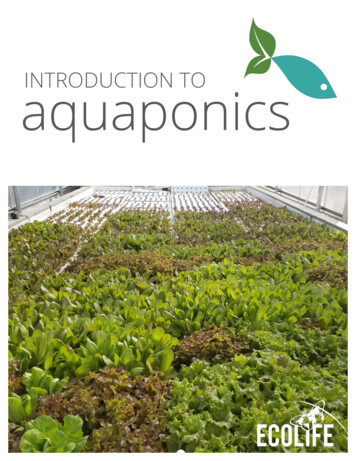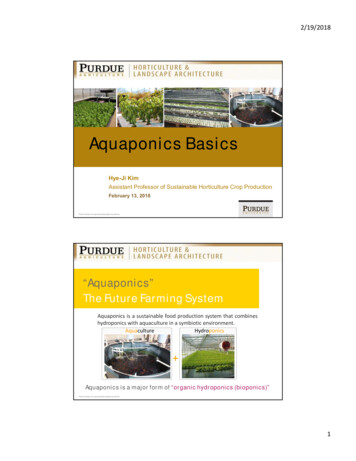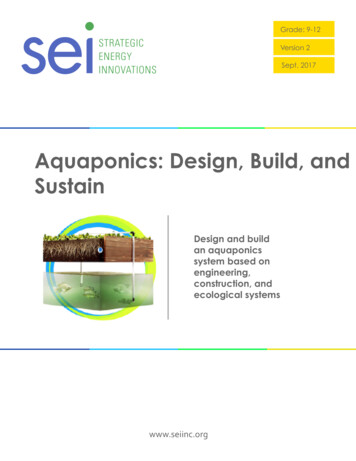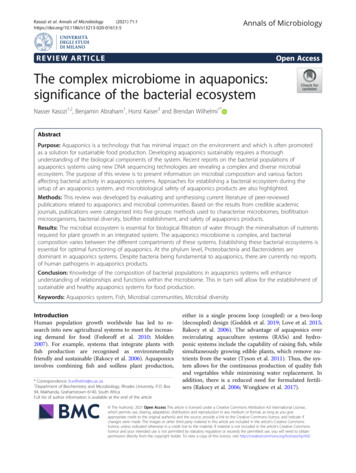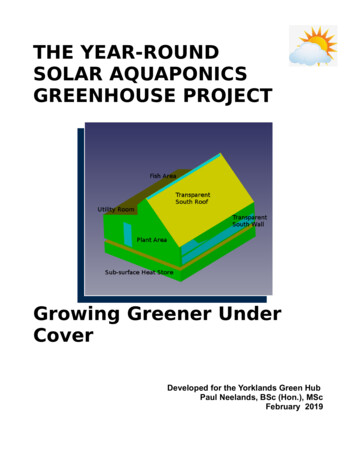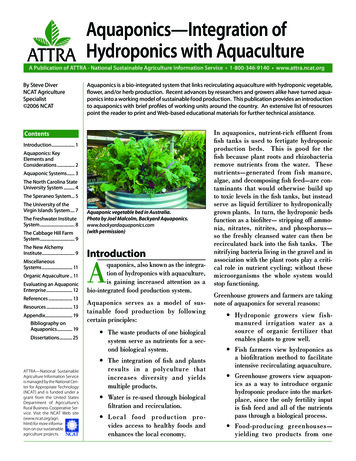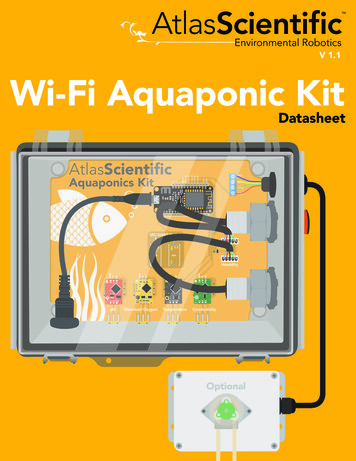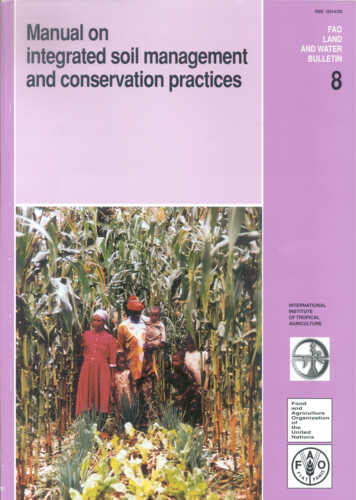
Transcription
ECO-CYCLEAQUAPONICS KITINSTRUCTION MANUAL
TABLE OF CONTENTS01AQUAPONICS 10102WHAT’S INCLUDED03GETTING STARTED05ASSEMBLING YOUR KIT09PLANTING YOUR SEEDS10CARING FOR YOUR ECO-CYCLE12FREQUENTLY ASKED QUESTIONS
THANK YOU!Thank you for reducing your environmental footprint and protecting naturalresources by growing aquaponically! Your ECO-Cycle Aquaponics Kit converts fish waste into a natural plant fertilizer, while using 90% less land andwater compared to traditional growing methods.The ECO-Cycle Kit is an easy, low-maintenance system that turns your12”x24” fish tank into an organic garden that will produce fresh vegetablesand herbs all year long.We hope you enjoy your ECO-Cycle and become inspired to learn moreabout the work of ECOLIFE Conservation at www.ecolifeconservation.org.AQUAPONICS 101Aquaponics is a sustainable method of food production combiningaquaculture (raising aquatic animals) and hydroponics (cultivating plants innutrient-rich water).In this circulating system, fish waste acts as a natural fertilizer for plants, whileplants take up those nutrients and return clean water to the fish.BENEFITS TO GROWING AQUAPONICALLY: 90% reduction in water and land use compared to soil-based growing. 97% reduction in water use compared to conventional aquaculture. Recirculating design helps to keep waste out of watersheds. Yields high-quality organic produce, without the use of harsh chemicalssuch as pesticides, herbicides, water conditioners, or added fertilizers. Systems are versatile and can be designed to fit in almost any space. Easy to maintain!1
WHAT’S INCLUDED:Your new kit includes everything you need to convert a 12”x24” aquarium into ablooming indoor garden.Grow TrayGrow Tray DoorNet Pot HolderT-BarsFilter Cover½” Drain FittingWater PumpLED Grow LightLED Tank LightNet PotsGrow LightController12” Pump Hose2
Grow Light Display2 Pre-Filter SpongesBio-Filter BrickPower SupplyClay PebblesAssembly ScrewsGETTING STARTEDBefore getting started, have the following ready: 12” x 24” tank 2 - 3 fish Powdered Vitamin C Fish food 1 - 2 packets of seeds Paper towels Phillips screwdriver Gravel and decor (Optional) Water heater (Optional) Siphon (Optional)3
WHAT CAN I GROW?Leafy greens and herbs grow best becausethey thrive in the nitrogen rich fertilizerproduced by fish waste. Customers haveexperienced great results with lettuce,basil, chard, kale, arugula, mint, cabbage,and a wide variety of leafy greens andherbs. The kit may also be used to startseeds for an outdoor vegetable garden,native plants for landscaping, tropicalhouse plants, and even trees.WHAT KIND OF FISH WORK BEST?The ideal fish for your system are goldfishand smaller tropical aquarium fish. One inchof fish per gallon is a common aquariumstocking recommendation. The actualnumber of fish will vary depending on thetype(s) of fish and their species-specific carerequirements. Goldfish Guppies Platys Swordtails Small Tetras Danios RasboraAs with any aquarium, biological filtration is required to keep the systembalanced and safe for fish. Nitrifying bacteria process the fish waste (ammonia), eventually converting it into nitrate (NO3) - which is utilized by the plants.Bio-filtration is accomplished by moving oxygenated water through asubstrate or media with a high surface area, on which nitrifying bacteriacolonize. The blue bio-filter brick in your ECO-Cycle provides this surfacearea. “Cycling” is the process of building up nitrifying bacteria colonies in thebio-filter, which can take up to six weeks.It is important to introduce the fish incrementally, starting with just two orthree. Once the system has "cycled", the tank will be ready to handle a largerbio-load. From there, fish may be added incrementally in small numbers untilthe target number is reached.4
ASSEMBLING YOUR KIT:ADD DECOR AND WATER:1) Rinse aquarium gravel and decor. Arrange the interior of the aquarium.2) Fill the tank with water to 95% capacity.INSTALL AND CONNECT LED TANK LIGHT:1) Remove the protective tape from the adhesive strips on the bottom ofyour LED bar and press against the bottom of the grow tray for 20 seconds.2) Route the cord through the accessory port on the right side of your growtray.Connect and adjust the water pump:1) Attach the hose to the waterpump.3) Feed the pump power cordthrough the square accessoryport on the back right side ofthe unit.2) Attach the other end of hoseto the drain fitting on the rightside of the grow tray.4) Set flow rate of pump to theminimum output by sliding theflow slider towards the nozzleof the pump. If the flow rate istoo strong it may cause tray tooverflow.5
5) Place the tray on the top of the aquarium, making sure that the tray sitsflush along the entire rim of the tank. Any other accessories, such as anaquarium heater or airstone, can be installed at this stage.6) Route all power cords and airlines through the accessory port onthe back of the tray.ASSEMBLE THE GROW LIGHT RACK:1) Place the base of the T-bars against the sides of the grow tray. Align theholes on the bars with the holes in the grow tray.2) Reaching inside the grow tray, thread the nuts around the screws tosecure the T-bars in place.3) Secure the light bars in place by lining up the holes at the top of the T-barsand fasten with the provided screws.4) Start grow light height at the lowest setting by unscrewing the locks at thetop of your light stand and adjusting the light bars. It is easiest to makethis adjustment one side at a time.5) As the plants germinate and grow,raise the light to keep a 2” - 4”distance from the top of the plants.This will ensure rapid germinationand full plant growth. If you noticeyour plants begin to burn, adjustaccordingly.6) Connect two cords from grow lightdisplay to grow lights.PLACE FILTERS IN GROW TRAY:Place two pre-filter sponges andbio-filter brick on the right side of thegrow tray. The pre-filter sponge shouldbe placed in the back and middlecompartments, and the bio-filter brickshould be in the largest rectangularcompartment.More information about the pre-filterand bio-filter sponges can be found onPage 10.6
HOW TO ASSEMBLE GROW LIGHT DISPLAY:1)Remove the grow-light controller from packaging. Apply velcro to the sideof the T-Bar and on the back of the remote.2)Slide the square brackets into the track on the front of your grow light.3)Using the screws provided and a Phillips screwdriver, fasten the clockdisplay to the square brackets on the front of your grow light.HOW TO SET CLOCK AND TIMER:1) Press the button labeled “SET CLOCK” on the controller. Using the hour andminute buttons set the clock to the current time. Please note the clockoperates in military time (1-24) .2) Press the button labeled “ON TIME” on thecontroller. Using the hour and minute buttonsset the clock to the desired “ON TIME”.3) Press the button labeled “OFF TIME” on thecontroller. Using the hour and minute buttonsset the clock to the desired “OFF TIME”.We recommenda 16-hourgrowth cycle!7
OPERATING YOUR GROW LIGHT:The ECO-Cycle offers three separate grow settings designed to optimize plantgrowth at each stage of development.SEEDStage 1: SeedThis setting will be used during the firsttwo weeks following the initial plantinguntil the first true leaves develop.GROWStage 2: GrowIf your plant is non-fruit-bearing you canleave it on this setting for the remainderof your plants’ life cycle.FLOWERStage 3: FlowerTurn on once vegetative growth is fullyestablished (after 4-6 weeks).PLANTING YOUR SEEDSYour system is designed to germinate seeds andgrow a variety of plants. Leafy greens and herbs canbe grown from seed all the way to harvest.Plants are grown in reusable expanded clay pebbles,which are contained in 17 net pots. Net pots allowthe nutrient rich water from the aquarium to flowthrough the media to the roots of the plants.START SEEDS USING THE WICK METHOD:Seeds may be germinated directly in the system by creating a simple wick ofpaper towel to provide moisture to the seeds.1) Rinse clay pebbles in water to remove dust build-up.8
2) Cut a paper towel into strips of1.5” x 5”. Place one end of thestrip in the bottom of net pot,with the rest positioned alongthe side, forming an L-shape.3) Add a thin layer of clay pebblesin the pot on top of the papertowel, about halfway up thenet pot.4) Fold the rest of the paper towelover on top of the clay pebbles.Using a spray bottle, dampenthe paper towel with a light mistof water to help the seeds stayin place.5) Add seeds to the top of damppaper towel. The number ofseeds will vary depending onthe type of plant - three tofive seeds works well for mostleafy greens and herbs.6) Cover seeds with another layerof clay pebbles, filling the netpot to the top of the perforatedarea.7) Place the seeded pot into thesystem.9
When all pots are in place, lower the grow-light fixture to its lowest setting ateight inches above the pots. Adjust grow light setting to ‘seed’ until all plantshave sprouted. The seeds will germinate over the next few days, and in mostcases, the first sprouts will emerge from the clay pebbles in four to sevendays, depending on plant variety. As your plants grow, raise the light to 2” - 4”over the top of plants. Switch light setting to ‘grow’ once plants have reachedtwo inches tall and true leaves are established.CARING FOR YOUR ECO-CYCLETHE GROW TRAY:Check the tray regularly to make sure the drain is free of any roots or otherdebris that could cause an overflow. Ensure the water flow is properlyadjusted and not overflowing the filter section.THE FILTER SECTION:The filter section is on the right end of the grow tray. It is comprised of apre-filter sponge (white) and a bio-filter brick (blue). The aquarium water flowsthrough these integrated filters prior to reaching the plant roots in the growtray.Pre-Filter Sponge (White)The pre-filter sponge serves to trapsolid waste and should be removedand rinsed weekly in warm water ormore frequently if necessary. Visuallyinspect the sponge regularly fordiscoloration and accumulated debris.VERYIMPORTANTto keep yourkit clean!Bio-Filter Brick (Blue)The blue bio-filter brick is composed of Matala media.This filter provides a high surface area for beneficialnitrifying bacteria to colonize. This filter should not beremoved or cleaned more than once every six months.Prefiltration by the white sponge will prevent the majorityof solid waste from reaching the bio-filter.Should the bio-filter become clogged, it can be removed and rinsed in a cupof water taken from your ECO-Cycle or tap water that has been treated toremove chlorine and chloramine. Rinsing in untreated tap water isdetrimental to the bacteria that live on the filter.10
FEEDING FISH:Feed fish according to their specific feeding requirements. Most community fishwill accept high-quality flake, freeze-dried, and frozen foods. Only feed as muchas fish will eat in three to five minutes.CLEANING YOUR AQUARIUM:Growing with the ECO-Cycle Kit helps ensure a balanced aquarium, wherethere are little to zero excess nutrients. That means less algae growth andreduced maintenance requirements in comparison to conventional aquariums.Biofilm, however, can gradually grow on the glass and solid waste willaccumulate on the gravel. These are best removed using a clean sponge, analgae pad on a stick , and a gravel vacuum. These pieces of equipment can beeasily maneuvered through the front door of the grow tray. Avoid algae build-upby choosing a location for your ECO-Cycle that is not in direct sunlight.HARVESTING PLANTS:Plants may be harvested all at once or by clipping a few leaves at a time. Ineither case, the plants should remain in place when harvesting, rather thanremoving the pots first. This will keep leaves clean from aquarium water. Whileyour kit will produce safe, organic produce and herbs, always wash plants withclean water prior to eating.Many greens will keep growing after being cut, but eventually the root mass willdistort the net pot so it is best to re-seed after every couple of harvests.ADDING WATER:Over time the water level will come down due to evaporation and transpiration.To keep water level consistent, water treated with Vitamin C should be added asneeded.TESTING WATER QUALITY:A well functioning system will stay withinthe parameters of the chart to the rightonce it has gone through it’s initial “cycle” up to a 6 week process.We recommend using the API FreshwaterMaster Test Kit to test your water.11
FREQUENTLY ASKED QUESTIONSQ: What size tank do you recommend?A: Any 15-30 gallon aquarium with a 12”x24“ footprint. The standard 20-gallontank is widely available with these dimensions. The tray can accommodateaquariums with top dimensions of between 23.75” - 24.25” x 11.8” - 12.5”/ 60.3- 61.6 cm x 30 - 31.8 cm). Tank size is also determined by the type of fish youwant to keep in your tank. The general rule of thumb is one inch of fish pergallon - a little less for goldfish.Q: What power source do you recommend?A: The ECO-Cycle can be plugged into either 110V or 220V power sources,which is common in most household outlets.Q: What kind of water should I use in my kit?A: Rainwater and pH neutral well water are the best choices for filling your kit.However, many people are limited to municipal tap water. Most municipalsources add chlorine and chloramine to water for disinfectant purposes. Thesecompounds make water safe to drink but are toxic to fish and to the nitrifyingbacteria in the bio-filter. There are several water conditioners available throughaquarium shops, but most of these products are not certified for use with fishand plants intended for human consumption. A safe alternative is powderedVitamin C (ascorbic acid). 1/8 teaspoon of Vitamin C will treat 20 gallons ofwater, effectively neutralizing the chlorine and chloramine.Q: What kind of fish food should I use?A: There are several sources for fish food that contain high quality proteinwithout artificial coloring. Fish food that contains feather meal has lownutritional value and can create a dirty tank.Q: Why is there some water gathered on the lid of my tank?A: If there is a heater in your tank and the room is cold, condensation is likelyto increase. Lowering the aquarium temperature a few degrees shouldalleviate this issue. Another cause of condensation may be the flow rate of yourpump. To reduce moisture build-up on the bottom of the tray, set the pump toits lowest setting. This reduces splashing from the drain line, and waterdraining through the extra overflow holes. Also check to see if the drain fittingis clear.12
Q: What is the brownish stuff growing on the glass and decor in my tank?A: The growth of brown diatomaceous algae and biofilm is a normal phase in anew aquarium. This will usually die off naturally and is later replaced by muchslower growing green algae. All of these are easily wiped from the glass usingan algae magnet or algae pad. The addition of a small algae-eating fish, such asa bushy-nose plecostomus, can also help to keep algae growth in check. In anycase, algae growth will be significantly reduced once your plants are wellestablished in the grow tray.Q: Why is my tank getting cloudy?A: Cloudy water is not uncommon in a new system. It is usually caused by abacteria bloom due to overfeeding, overcrowding, or adding fish too quickly. Itis important to provide enough food without overfeeding the fish. Most fishshould be fed 2-3 times per day, but only as much as the fish will consume inthree to five minutes. If you have a cloudy tank, do one or two 30% waterchanges and reduce the feeding amount.Q: Can this system be used with turtles or aquatic frogs?A: Yes. However, due to the salmonella risk associated with reptiles andamphibians, we do not recommend growing edible plants.Q: Can I use saltwater?A: Our ECO-Cycle is primarily designed for use in freshwater aquariums andusing freshwater fish to grow edible plants. However, it’s possible that caulerpaor other marine algae could be cultured in the grow tray, if the pots areremoved to open up the space. A marine system of this type would servescientific or ornamental purposes only and would not be for food production.Q: What do I do if a part breaks? Do I have warranty?A: The grow lights have a one year warranty from your original purchase date.All other components may be replaced up to six months from the originalpurchase date.Q: My question wasn’t answered! What now?A: We want you growing! If you experience any issues with your kit, please callour office for a custom troubleshooting session. We’re happy to help!The ECO-Cycle Aquaponics Kit and manual is protected by copyright and may not be copiedwithout permission from ECOLIFE. 2017 United States Patent No. US 8,966,816B2ECOLIFE Conservation is a designated 501c3 nonprofit organizationfunded by philanthropic individuals and community support.13
101 North BroadwayEscondido, California 92025760.740.1346www.ecolifeconservation.org
03 GETTING STARTED. AQUAPONICS 101 Aquaponics is a sustainable method of food production combining aquaculture (raising aquatic animals) and hydroponics (cultivating plants in nutr
